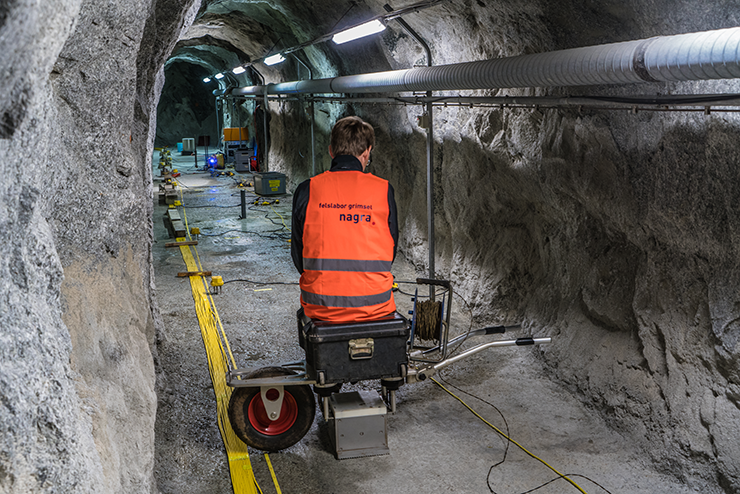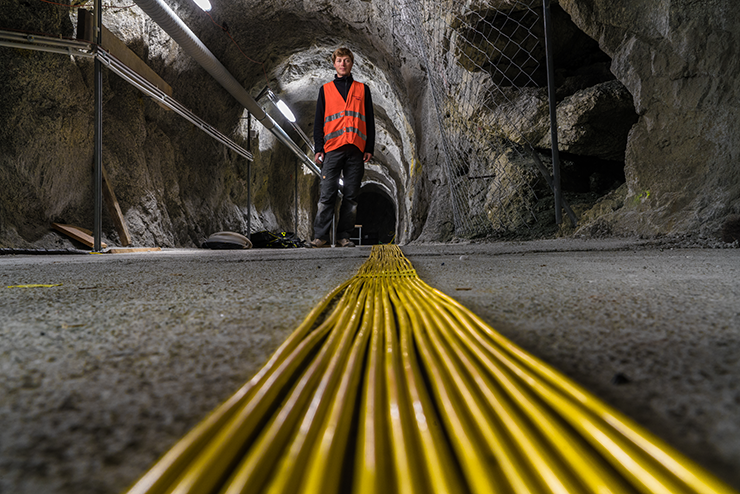Fibre-optic technology encounters 300-million-year-old granite
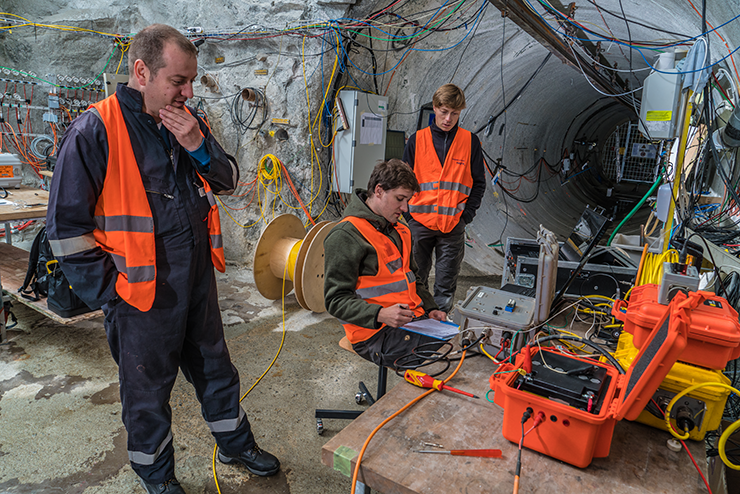
July 2018 - by Benedikt Galliker
Fibre-optic cables are hidden deep inside the granite of the Aar Massif. Just as if they were a huge microphone they record acoustic waves and enable scientists from the ETH Zurich to listen to the mountain. This fibre-optic technology is being tested at Nagra’s Grimsel Test Site to be used later for monitoring deep geothermal projects and other underground projects.
Yellow cables and small boxes lie on the floor of the laboratory tunnel. Among them is a man in an orange reflective jacket seated on a kind of wheelbarrow. He urges me, “Please don’t move”. A soft vibrating sound and all is quiet again. He explains that measurements are in progress and that his “wheelbarrow” is actually a miniature vibrator vehicle that generates acoustic waves. These are registered by the yellow fibre-optic cables and the small boxes – geophones.
Using fibre-optic cables to record acoustic waves
In the next tunnel, I meet ETH project manager Dr. Joseph Doetsch who is looking at measured data on his computer. Together with Professor Andreas Fichtner and Cédric Schmelzbach from the ETH Zurich, he is investigating geophysical applications of fibre-optic technology. “We are using three kilometres of fibre-optic cables to capture acoustic waves. These are generated by very small, natural earthquakes or artificially with hammers and the vibrator vehicle”, the researcher explains. “Acoustic waves are also generated in rock when fluid is injected under pressure”, Doetsch continues. “This is important for deep geothermal energy and we are trying to achieve a better understanding of the physical processes involved”.
Making use of existing infrastructure
The Swiss Competence Centre for Energy Research – Supply of Electricity (SCCER-SoE) already conducted similar experiments on deep geothermal systems at the Grimsel Test Site last year. On a small scale, the “In-situ Stimulation and Circulation” Experiment (ISC) investigated how rock cracks as a result of the injection of water and how this alters rock permeability which is the basis for an efficient heat exchanger. The fibre-optic experiment is an extension of the ISC experiment and uses the existing infrastructure. This includes fibre-optic cables in six boreholes drilled into the granite as well as highly sensitive geophones installed in boreholes and along the tunnel walls. A seismometer operated by the Swiss Seismological Service (SED) of the ETH Zürich in Nagra’s research tunnel which permanently monitors earthquakes is also used here. For the latest measurements, Doetsch and his team had to lay out only one more kilometre of fibre-optic cable, connect it with the existing cable and set up a few additional mobile geophones.
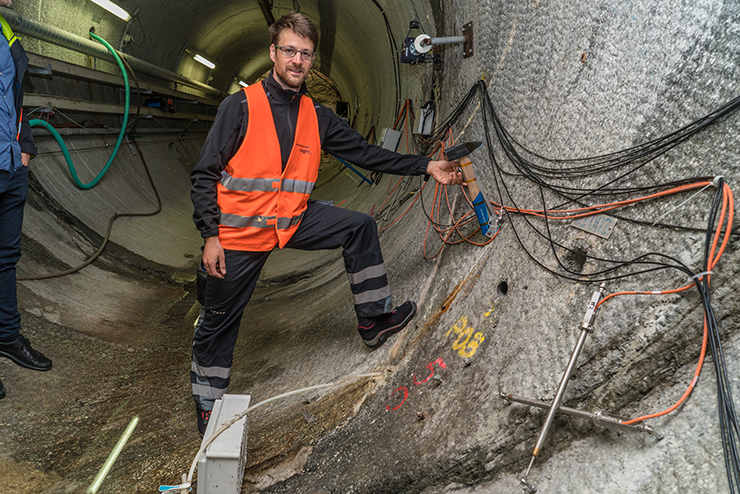
ETH project manager Dr. Joseph Doetsch sees great potential: “Fibre-optic technology can revolutionise acoustic wave measurements!”
Comprehensive testing of fibre-optic technology
“Experimenting with fibre-optic technology is very exciting”, emphasises Joseph Doetsch: “We can measure acoustic waves with different frequencies using both fibre-optic cables as well as classic sensors such as geophones and the seismometer. We then compare the measured data from the different sources”. In this way, the scientists can determine how well the fibre-optic technology works. After comprehensive tests with artificially generated acoustic waves, the measurement system will remain switched on in the following weeks. Doetsch and his team hope to register small natural earthquakes.
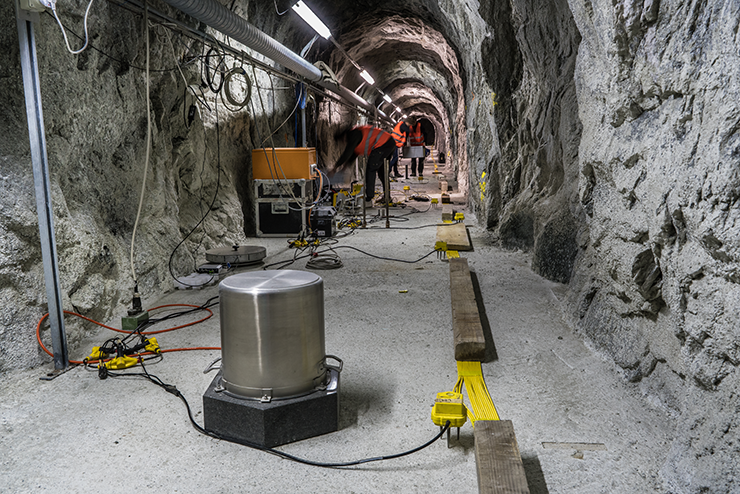
The test tunnel with the SED seismometer (grey “pot”), the mobile geophones (yellow boxes) and the fibre-optic cables (yellow cables).
Revolutionary measuring technology
With this innovative measuring technology, the fibre-optic cable serves as the sensor. Acoustic waves are measured with light pulses instead of electrical signals as used in classic sensors. The light pulses are transmitted through the optical fibres, scattered back along the cable and recorded again at the point of origin. When an acoustic wave arrives, it expands not only the surrounding rock but also, to a small degree, the fibre-optic cable, and this influences the light signal (more about the measurement principle). These changes in the light pulses thus contain relevant information about the location as well as the strength of the acoustic waves. The great advantage of fibre-optic measuring technology is that the measuring points are distributed along the entire length of the cable. “You could say we have hundreds of sensors operating simultaneously rather than just a few at isolated locations. Therefore, fibre-optic technology can revolutionise the measurement of acoustic waves”, explains Doetsch. This technology can be applied not only for monitoring deep geothermal energy projects and boreholes used by the gas and oil industry but also in the monitoring of pipelines and terrain.
Possibilities for Nagra
Nagra project manager Dr. Tobias Vogt is pleased with the progress. “We already use fibre-optic technology to determine temperature distribution”. He can imagine that, in the future, acoustic wave measurements using fibre-optic cables could also be used in experiments in the rock laboratory and in deep boreholes to detect very small changes in the rock. “I am excited about the analysis of the measurements”, says Vogt.
This article was first published on the Nagra blog.
Author

Benedikt Galliker is technical-scientific editor at Nagra. He writes articles and takes photos for print products, the internet and the Nagra blog on subjects related to nuclear waste management.

